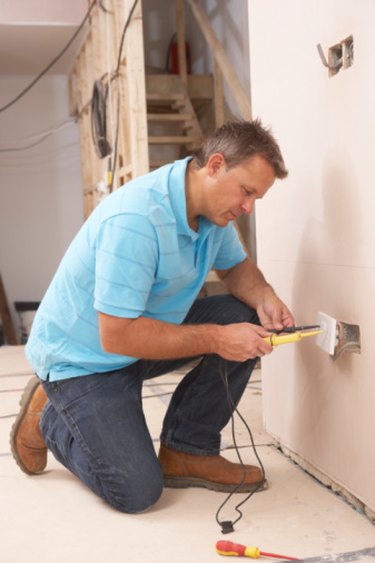Things You'll Need
Electrical service panel
Screwdriver
Hammer
Slip-lock pliers
Knock-out clamps
8-gauge ground wire
Ground rod
Ground clamp
Circuit breakers
Electrical cable
Drill
Drill bits and hole saws
Wire staples
Assortment of electrical boxes
Switches, outlets and light fixtures

Electric companies distribute residential power over an array of power lines to ensure that every home is equipped with a reliable source of electricity. They employ a corps of specialists to keep the lines secure and working but their responsibility ends at the point where their lines enter your home. From that point on, hire a licensed electrician to wire your home or do it yourself. If you choose the latter option, you should take the time to familiarize yourself with electrical code requirements so the electricity works properly and your home is safe.
Step 1
Cut off the power. Have the power company shut off the service to your house or disconnect the power leads from the meter on the side of your house. Check to make sure it is off before beginning work.
Video of the Day
Step 2
Install an electrical panel at the point where the leads from the power company enter your home. Knock out holes in the panel for the power leads with a hammer and screwdriver and screw knock-out clamps into the holes with slip-lock pliers. Feed the cables through and tighten the clamps. Loosen the lugs on the brass bus bars, feed the red cable into one and the black cable into the other and tighten the lugs. Attach the white cable to the silver bus bar in the same way.
Step 3
Pound a metal ground rod into the earth and run a length of 8-gauge copper wire from the panel to the rod. Connect one end to the rod with a ground clamp and the other end to the ground bus on the service panel. If metal water pipes enter the house, find the ground rod nearby and connect it to the pipes with another length of 8-gauge wire.
Step 4
Connect each electrical circuit in the house to the panel by means of a circuit breaker. Feed each circuit cable through a knock-out hole in the panel, to which you have attached a clamp. Connect the white wire of each cable to the silver bus, the ground wire to the ground bus and the black wire to a breaker. Snap each breaker onto an available slot on the brass bus. For 240-volt circuits, connect the red and black wires to separate breakers on a paired set.
Step 5
Run the cables from the panel throughout the hose by drilling holes in the floor and walls as needed. Plan the circuits to minimize the amount of cable you have to use while ensuring you do not overload the breaker on any circuit by connecting too many elements. Staple the cables to floor joists, roof rafters and wall studs wherever it is loose. When you drill holes in wall studs, keep them at least 1 inch from either face so that you don't pierce them with drywall screws.
Step 6
Install an electrical box at each location of an outlet, switch or light fixture. In most cases, you can nail the boxes to studs or rafters, but if the wall is already covered, you can also use a remodeling box that attaches directly to the drywall. Whenever you have to join two cables together, do it inside an electrical box. It is hazardous, and a violation of code, to leave twisted and capped wires exposed.
Step 7
Size the cable according to the breaker controlling the circuit. You can use 14-gauge cable for 10- and 15-amp breakers but you need 12-gauge wire, which is thicker, for 20-amp breakers. Tim Carter, of Ask the Builder, recommends 12-gauge as the minimum wire size. Use 10-gauge, four-strand cable for each 240-volt appliance that requires a 30-amp breaker and use 8-gauge wire if it needs a 50-amp breaker. Each 240-volt appliance should be on a dedicated circuit.
Step 8
Follow the convention of connecting black and white wires to brass terminals, white wires to silver and bare wires to green ones when connecting circuit elements.
Tip
Use Ground Fault Interrupting (GFI) outlets anyplace where water is likely to be present, including the bathroom, kitchen, laundry room and outside. GFI's prevent injury and damage to machinery by tripping whenever they detect a sudden increase in current.
Warning
Because of the hazards involved, Carter recommends taking a course in electrical wiring before attempting a major project yourself.
Video of the Day